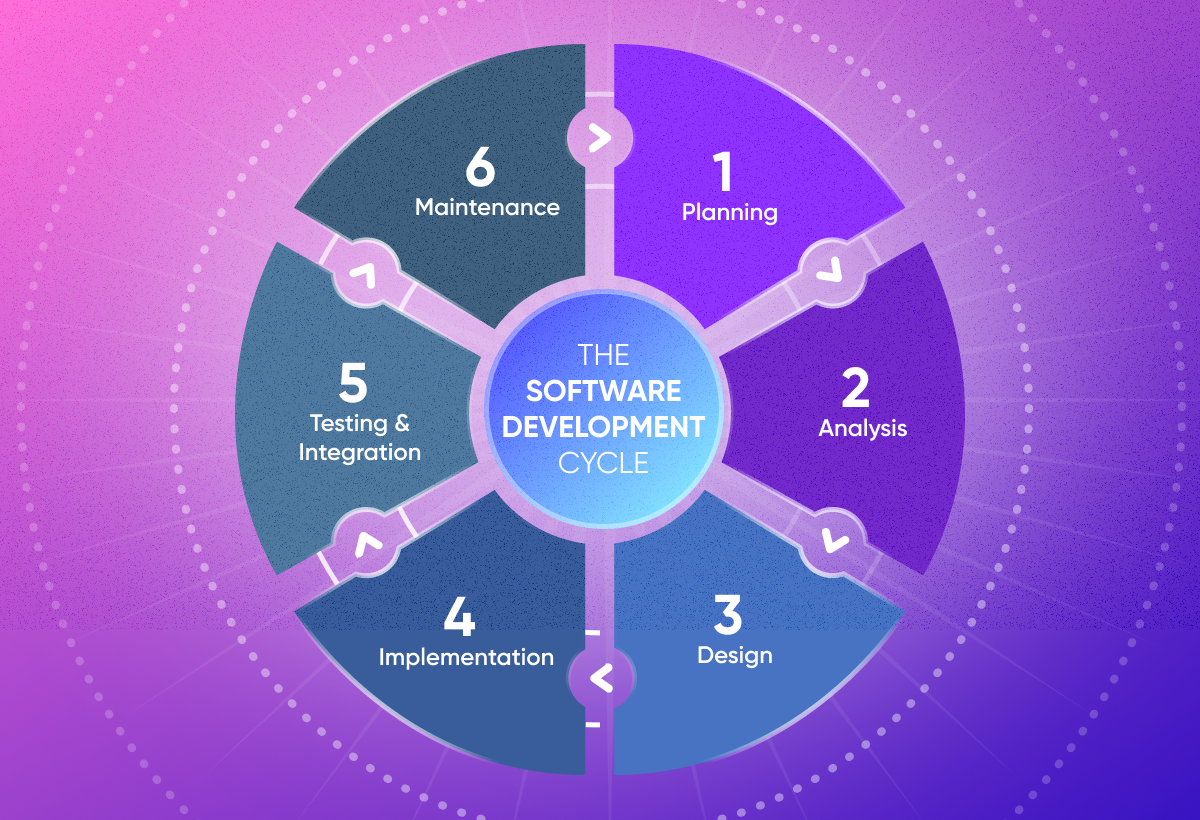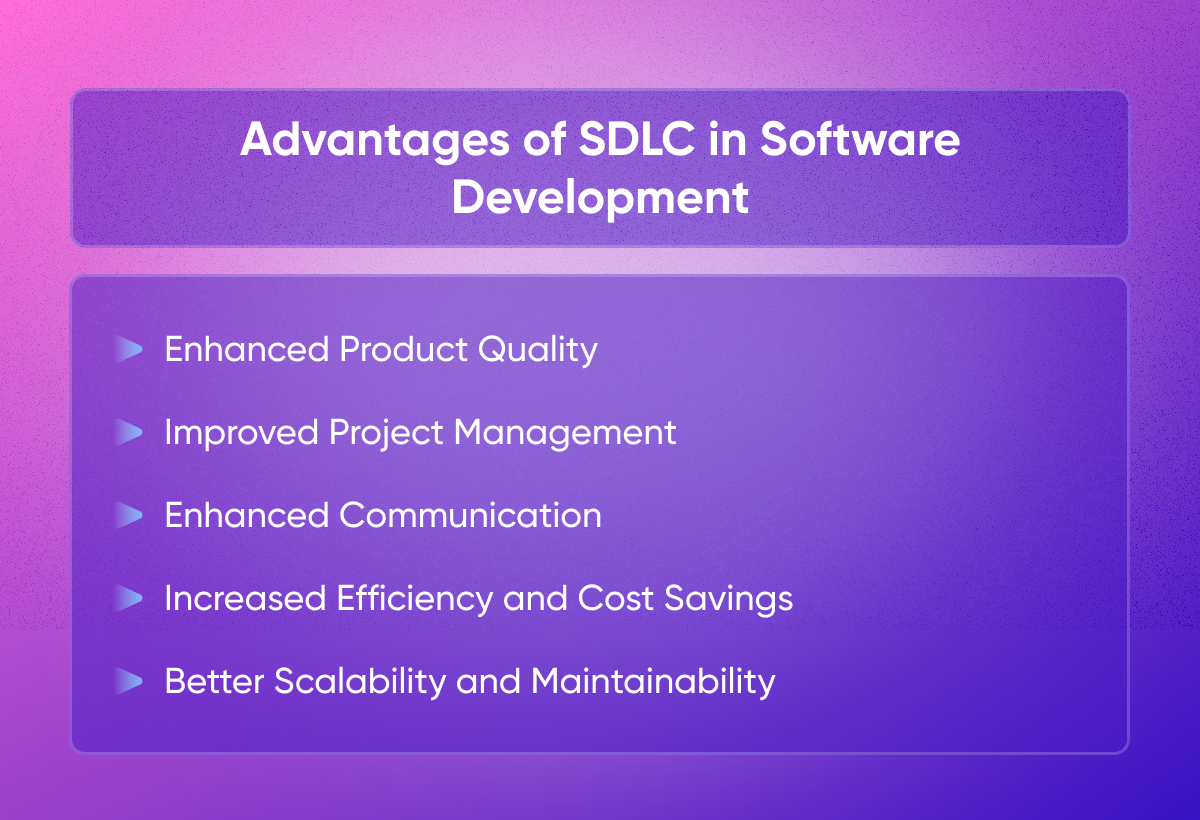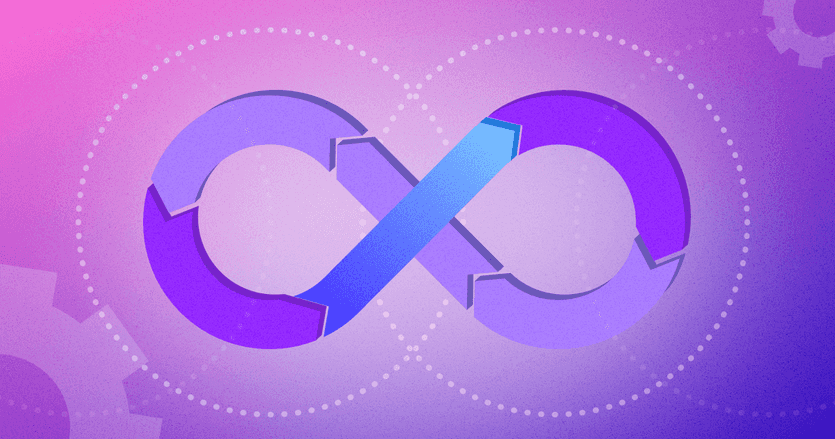Have you ever wondered about the intricate process behind bringing the software we use daily to life? The key lies in the Software Development Life Cycle (SDLC), a structured framework that steers the entire journey from conception to deployment. Our developers actively employ this methodology. In this article, I am delighted to offer a comprehensive perspective on the role of this methodology in the software development process.
What is the Software Development Lifecycle?
The Software Development Lifecycle (SDLC) is a structured process that outlines the entire journey of software creation, from conception to deployment and maintenance. It's a roadmap that ensures high-quality software is delivered efficiently and effectively.
For example, in a case study developing a secure mobile banking app, SDLC ensures high quality and security, reduces risks, improves flexibility and adaptability, and facilitates better communication and collaboration.
This process offers advantages not only to managers but also to developers and customers. Project managers gain enhanced visibility into the project status, facilitating informed decision-making and proactive risk management. The structured approach allows for the early identification of potential risks, enabling the implementation of proactive mitigation strategies.
Early defect detection and proactive testing play a crucial role in minimizing rework and associated costs. Additionally, efficient development processes and the delivery of high-quality software provide businesses with a competitive edge.
The Phases of the SDLC

The Software Development Lifecycle involves planning, designing, development, testing, deployment, and maintenance.
For example, developing a culinary social media app involves meticulous planning, designing a user-friendly interface, coding the front and back-end, integrating APIs, conducting rigorous testing, submitting to app stores, continuously fixing bugs, adding features, monitoring performance, and updating security to ensure a successful and user-centric app. This is not a fictional example, but a real case of our client, for whom we did the entire SDLC cycle: from planning and design to development and testing.

Let's delve into the specifics of each cycle to help you, whether you're a founder or a developer, comprehend the significance of each step.
Planning
This is the stage where the project manager takes center stage. It involves thorough discussions about the project, encompassing your budget and preferences, which your manager then translates into an estimate. What does this estimate entail?
- Timelines for task execution (typically organized into 2-week sprints)
- Budget breakdown (at Movadex, for instance, we employ an hourly rate)
- The team of specialists dedicated to your project (commonly including a project manager, designer, developers, and a quality assurance specialist)
Requirements Analysis
If it can be summed up in a single word, it's documentation: encompassing your project logic, technical requirements, and business processes.
Establishing software or product requirements equips teams with the insight and context required for the development and delivery of their software solutions.
Design
Alternatively, you might refer to it as prototyping and its creative process.
This encompasses crafting design documents, establishing coding guidelines, and engaging in discussions about tools, practices, runtimes, or frameworks. These choices are aimed at aligning with the software requirement specifications and goals outlined during the earlier requirements-gathering phase.
Implementation (Development)
This phase is time-consuming yet vital. It's the point where the Figma design starts to materialize, albeit currently only on the test server.
The aim is twofold—ensuring top-notch code quality and minimizing turnaround time.
Typically, this stage involves more people. While a single person may suffice for the preliminary design, at least two individuals are needed for development. They work under the guidance of the project manager and their team leader.
Testing & Integration
Developers rarely produce bug-free code initially, necessitating the intervention of a tester. Testing can be conducted manually or automatically.
In manual testing, every aspect is scrutinized by hand. For example, a tester navigates through each app page, examining visuals and identifying potential crashes. Conversely, automated testing employs specialized tools to execute pre-defined scripts, which guide testing tools in conducting tests and validating results. While both methods are reliable, automated testing is often pricier due to the need for additional skills, despite being generally faster. On the other hand, manual testing may take longer, but it is often more cost-effective on an hourly basis.
Maintenance
Maintenance involves ongoing updates, bug fixes, and enhancements. Many clients choose to collaborate with agencies to consistently enhance their products or services over time.
Advantages of The Software Development Lifecycle
Taking a historical perspective, the earliest mentions of a software development process can be traced back to the 1960s. During this time, system development lifecycles were established to guide the organized creation of software. Over the years, this process has undergone continuous refinement. A pivotal moment occurred in the 2000s with the introduction of the Agile Unified Process, marking a significant evolution in the software development lifecycle. Since the advent of Agile methodology, the trajectory of software development has experienced a transformative shift.
This methodology boasts the most advantages, which I've outlined for you below.

Enhanced Product Quality
The structured approach of SDLC minimizes errors by implementing comprehensive testing at each phase, identifying bugs early on and preventing expensive fixes down the line. For instance, there's no need to test every button on the design when the front-end hasn't completed its task. This hierarchy allows for a focused approach, prioritizing the completion of work first before delving into testing.
Moreover, contemporary SDLC methodologies harness the power of data analytics tools to monitor user behavior and interactions. Extracting valuable insights from this data illuminates the intricacies of user engagement with the interface, guiding subsequent design decisions and ensuring an ongoing trajectory of improvement.
Improved Project Management
For example, well-documented code and project artifacts enable easier maintenance, troubleshooting, and future enhancements. SDLC seamlessly incorporates changes in project requirements by employing structured change management processes. This approach not only facilitates the project manager in efficiently overseeing both the team and stakeholders but also allows for proactive identification of risks and the implementation of mitigation strategies, thereby minimizing the likelihood of project delays and unexpected costs.
Enhanced Communication
SDLC promotes project success by creating transparent communication channels and comprehensive documentation of objectives, expectations, and responsibilities. Beyond fostering clarity, SDLC actively enhances stakeholder engagement through consistent communication updates and feedback loops, providing stakeholders with ongoing insights into project developments. And, of course, by prioritizing precision and comprehensiveness in communication, SDLC minimizes errors and the necessity for rework.
Increased Efficiency and Cost Savings
Through early detection and resolution of errors, SDLC prevents the need for costly revisions and efficiently utilizes resources. By implementing streamlined workflows and standardized practices, SDLC enhances overall efficiency, reducing the time-to-market for the software. SDLC also contributes to improved resource allocation by its well-defined phases and deliverables. This clarity enables project managers to allocate personnel and resources more efficiently, matching the demands of each development stage. Clear project planning, coupled with effective risk management strategies, empowers project managers to accurately budget for the entire development lifecycle.
Better Scalability and Maintainability
Transparent documentation facilitates the seamless integration of new developers and ensures the efficient upkeep of the codebase. SDLC's iterative approach enables the smooth incorporation of fresh features and modifications without jeopardizing the integrity of existing functionality.
Examples of a Software Development Life Cycle Model
Over the years, various models have emerged to delineate and illustrate the Software Development Life Cycle processes. In the following sections, I'll delve into some of the most popular and time-tested approaches. I'll outline the advantages and disadvantages of each, and provide insights into the optimal scenarios for their application.
Agile
The Agile method is one of the most popular software development methodologies to date. The methodology represents a project management approach wherein projects are segmented into phases, highlighting ongoing collaboration and improvement. Teams engage in a cyclic process of planning, executing, and evaluating, fostering adaptability and responsiveness throughout the project lifecycle. One of the primary strengths of Agile lies in its flexibility. The iterative nature allows for continuous adaptation to changing requirements. Regular feedback loops with stakeholders ensure that the evolving product aligns closely with user expectations.
Agile is particularly well-suited for projects with evolving or unclear requirements, as it accommodates changes throughout the development process. It thrives in dynamic environments where regular adjustments are necessary to meet shifting market demands. Agile is an excellent fit for small to medium-sized teams that can benefit from its collaborative and communicative nature. Projects where user feedback is crucial for success, and rapid delivery of minimal viable products (MVPs) is desired, find Agile to be highly effective.
Advantages
- Flexibility Agile's iterative nature allows for continuous adaptation to changing requirements. Agile supports changes and evolution of the product requirements from very early in the process.
- Stakeholder Engagement Regular feedback loops with stakeholders ensure that the evolving product closely aligns with user expectations.
- Evolving Requirements Management Well-suited for projects with evolving or unclear requirements.
Disadvantages
- Documentation Challenges: Agile's focus on working software over comprehensive documentation may pose challenges in projects where detailed documentation is crucial.
- Not Ideal for Fixed Budget and Timeline Projects: In larger projects or those with a fixed budget and timeline, Agile's adaptability may pose difficulties in predicting the final project outcome.
- Dependency on Team Collaboration: The success of Agile heavily depends on effective team collaboration, and challenges may arise if there are communication gaps or conflicts within the team.
Waterfall
The waterfall model, introduced in 1956, stands as one of the earliest models devised to outline the software delivery process. This model adopts a linear sequential approach, where a series of phases unfold in a cascading manner, akin to a waterfall. Each phase's conclusion triggers the commencement of the subsequent one, ultimately culminating in the completion of the final product after the last step.
The Waterfall is best suited for projects with well-defined and stable requirements, where changes are unlikely to occur during the development process.
Advantages
1. Clear Structure
Each phase has well-defined objectives and deliverables, so it’s easy to understand and implement.
2. Comprehensive Documentation
The waterfall model emphasizes thorough documentation at each phase, providing a detailed record of the project's progression.
Disadvantages
1. Limited Flexibility
The rigid nature of the waterfall model makes it less adaptable to changes.
2. Late User Feedback
User feedback is typically gathered after the completion of the entire project. This delay can result in the discovery of misalignments between the final product and user expectations.
Iterative
In the iterative model, software evolves through repeated cycles, allowing teams to learn and adapt based on earlier experiences. Starting with essential requirements, additional features are identified and incorporated in multiple iterations, leading to the final product. The modular approach enables independent development and testing of each feature, akin to a sequential approximation method, gradually refining the software.
The iterative model is best suited for projects with evolving or unclear requirements, where constant refinements are necessary. It is effective when stakeholders require early deliverables and when the project can benefit from continuous feedback and improvement.
Advantages
1. Independent Feature Development
The modular nature of the iterative model allows for the independent development and testing of each feature.
2. Continuous Improvement
Teams can enhance the software based on learnings from each iteration, ensuring a continuous improvement process throughout the development life cycle.
Disadvantages
1. Complexity
The iterative approach may introduce increased complexity, especially if the project requires numerous iterations or if changes are frequent.
2. Resource Intensive
The model demands more resources as each iteration requires thorough testing and validation, potentially extending the development timeline.
Prototype
Prototyping stands as a common approach in software development, facilitating an early understanding of customer requirements and enabling the incorporation of user feedback to expedite the development of the final product. Each prototype functions as an independent application, and if well-received by users, the logic used in its creation can be reused, streamlining the development process.
The prototype model is best applied in projects where user feedback is crucial, and requirements are not well-defined initially.
Advantages
1. User Feedback
Prototyping allows for early and continuous user involvement.
2. Rapid Development
Prototyping supports the rapid development of the system, facilitating quick iterations and adjustments based on user feedback.
3. Risk Reduction
Early identification of issues and modifications through prototyping reduces the risk of developing a final product that does not meet user expectations.
Disadvantages
1. Not Suitable for Large Projects
The prototype model is less suitable for large-scale projects where the complexity and scale may make it challenging to manage and control.
2. Potential for Scope Creep
Without effective management, the prototype model can lead to scope creep as users may request additional features during the iterative prototyping process.
Conclusion
The choice of method depends entirely on your project and its unique characteristics. If you find yourself uncertain about the development process, feel free to reach out to us. Our project managers boast an average of 5 years of experience, designers bring in 4 years, developers have an average of 5 years, and our quality assurance specialists have 2 years of experience.
Select the option that aligns best with your needs, and be assured of a stress-free decision-making process – we prioritize transparency and provide a personalized approach, never rushing our customers.




